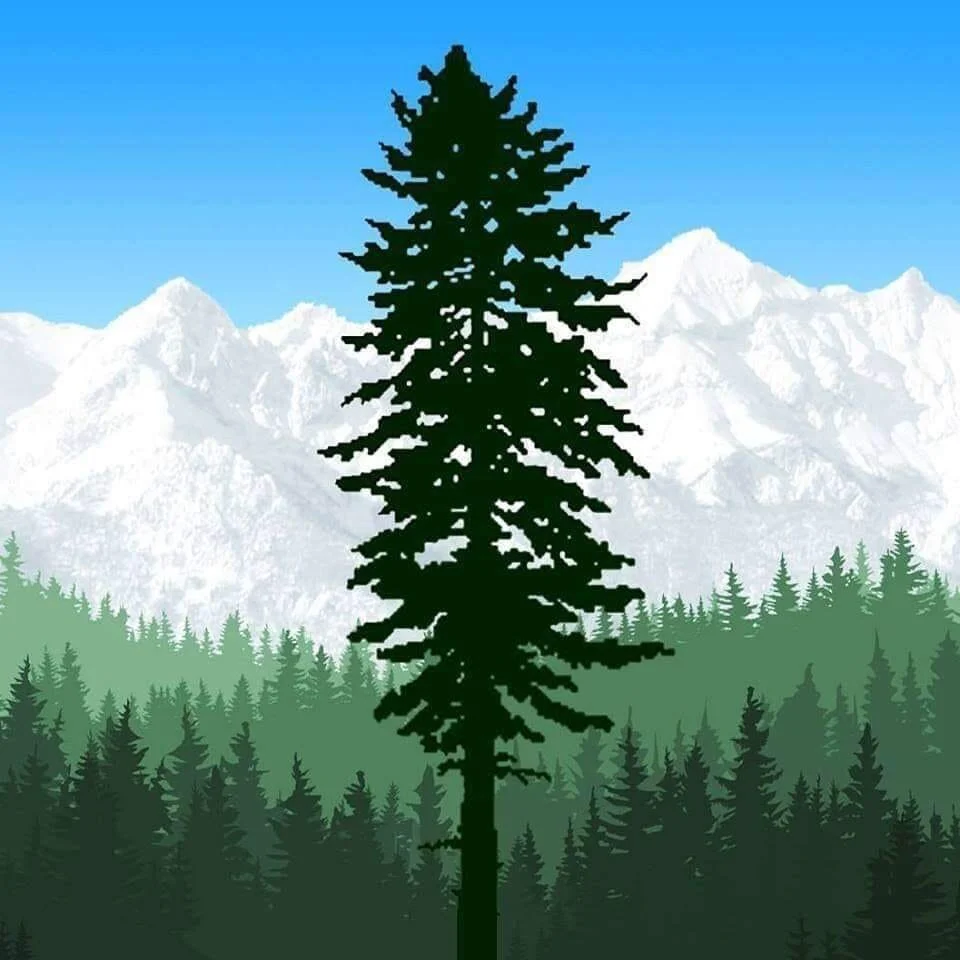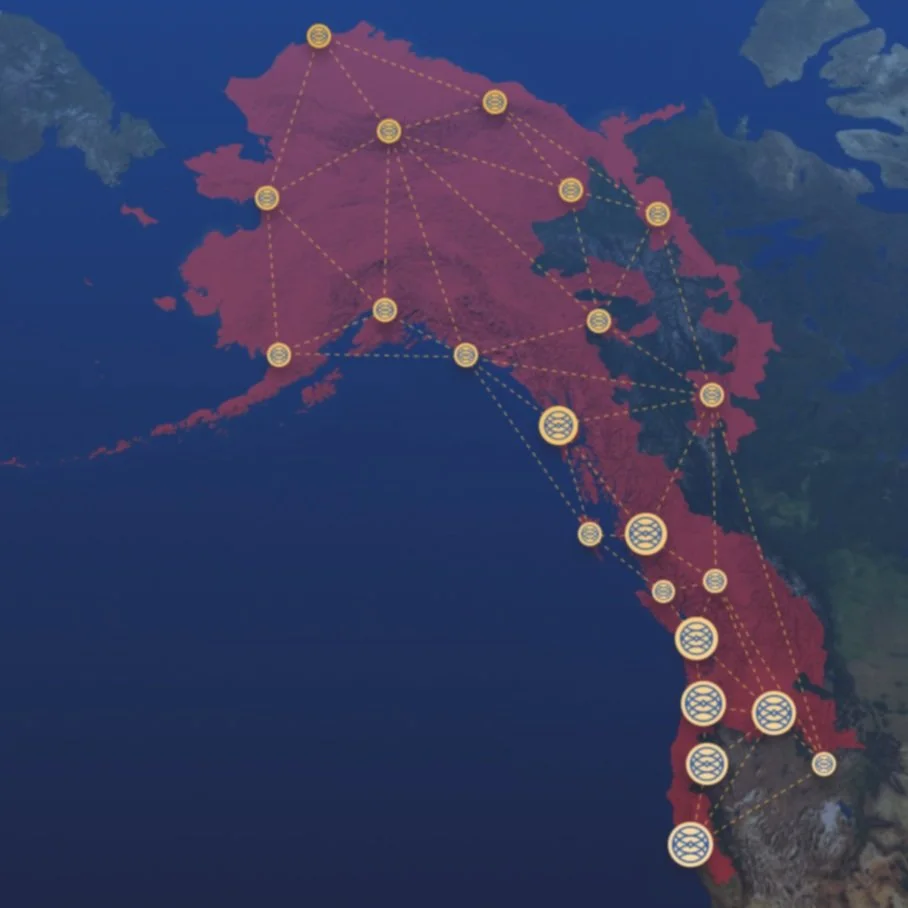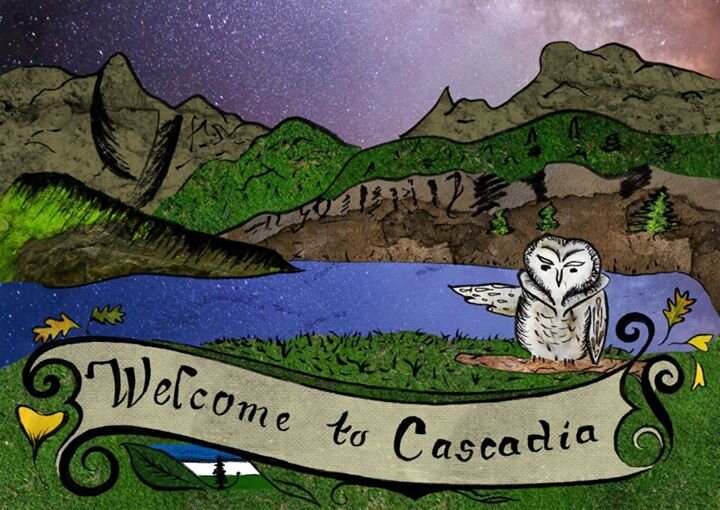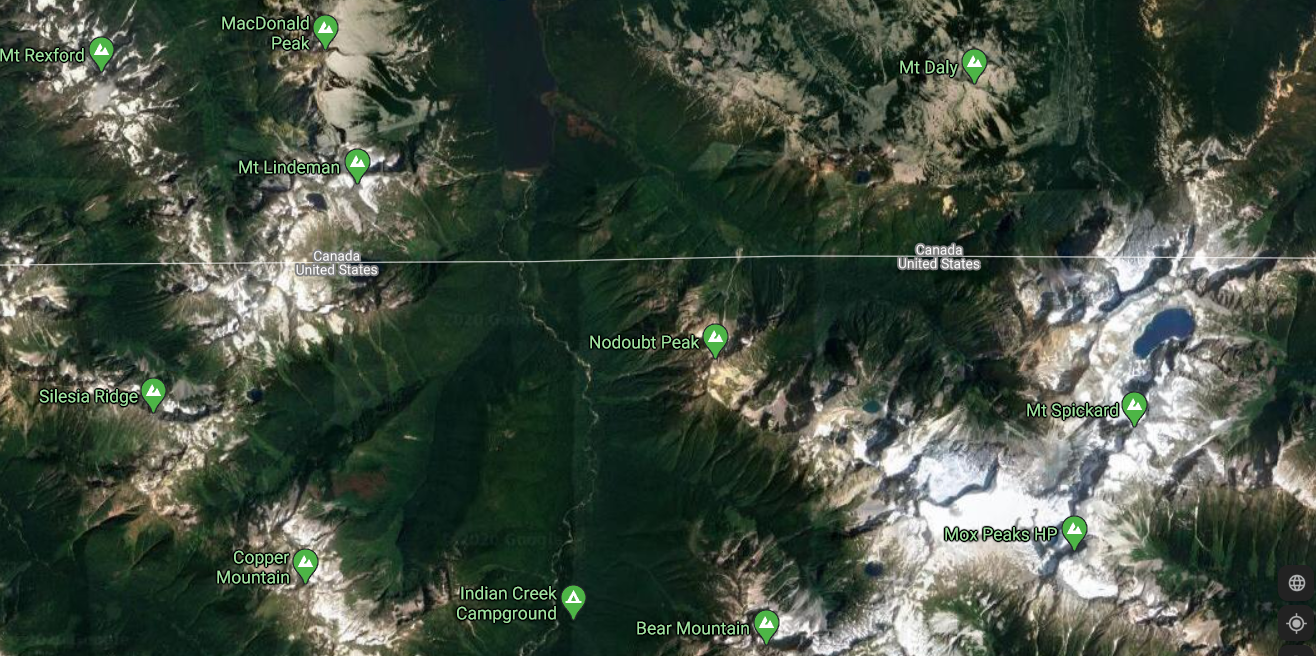Anti-Racist, Anti-Fascist, Always Cascadian. We have no idea who did the first run of these, but they are awesome so we are doing a second round. Now available in pre-order, grab them in bulk and get them to friends, family & every Cascadian.
For Pride, we are proud to present our Cascadia Pride flag redux featuring the Philadelphia Pride flag.
The Sound of the Northern Paiute language / Numu / Paviotso (Numbers, Greetings & The Book of John)
The Northern Paiute language, also known as Numu and Paviotso, is a Western Numic language of the Uto-Aztecan family. Within Numic, it is most closely related to Mono and more distantly to Panamint, Shoshone (spoken in Nevada, Idaho, Utah, and Wyoming), Comanche (spoken mainly in Oklahoma, Texas, and Arizona), Kawaiisu, and Chemehuevi-Southern Paiute-Ute. The other Uto-Aztecan languages of California are Tubatulabal and the Takic languages (Cahuilla, Cupeño, Gabrielino, Juaneño, Kitanemuk, Luiseño, Serrano, and Tataviam).
Cascadia Day is Tomorrow, Monday May 18th! Come Celebrate
Join a Cascadia Work Group
We are excited to announce that we are creating several work groups from our Envision Cascadia Conference, and would love to invite you to join us. We had more than 150 people register for 8 different sessions that took place over 2 weeks in which people gathered to explore how we can best build the Cascadia movement, and we are very excited to keep this momentum going.
#Cascadia trending after #WestCoastPact announced by governors
After Washington, Oregon, and California governors announced the launch of a Western States Pact in the face of a federal government unwilling to act on COVID-19 relief, #Cascadia , #Calexit and #Secession quickly began trending on twitter and other social media platforms.
Washington, Oregon and California agree to Western States Pact
Bioregionalism & Football: Welcome to Cascadia - New article by @MagazineCaviar & @FCGeopolitics
Inspired by a FC Geopolitic Twitter thread documenting the Cascadia Football Team and their first appearance at the CONIFA World Cup in London in 2018, online sports magazine Caviar released a wonderful article on Sports and Bioregionalism.
Remembering Mike Barnes - By Lansing Scott
Announcing Cascadia ZOOM Organizing Calls
Watershed Guide: A Companion to Living Here by the Frisco Bay Mussel Group (1977)
4 Ways Cascadians Can Respond Bioregionally to COVID-19
As the COVID-19 outbreak disrupts nearly every aspect of our daily lives, Cascadians should double-down on bioregionalism to better support our impacted communities and mitigate health risks.
What Does Bioregionalism Have to do with COVID-19?
Bioregionalism is a philosophy and lifestyle which promotes personal and community well-being by using naturally defined borders, such as waterways, as a structure for making sustainable choices. Bioregions are considered the largest region one can reasonably call home, encompassing familiar fauna, flora, and human-based culture or traditions. A de-colonized way of looking at the land, bioregionalism encourages one to ask how their actions better or preserve the place that they live, not only for themselves but for their neighbors and future generations, regardless of arbitrary state or federal borders drawn on by colonizers. Cascadia is just one of many bioregions of the world and stretches from Alaska down to Northern California, with borders shaped by the Snake, Frasier, and Columbia rivers and Pacific Ocean (also known as the Salish Sea).
Cascadia and COVID-19 are now deeply intertwined, with Cascadia having a large portion of the COVID-19 cases reported in the U.S. and with Cascadian businesses and citizens currently taking the brunt of the economic fallout of the virus. Cascadia is also on the world stage, leading the charge against COVID-19 through vaccine research, providing technology infrastructure through which people are staying connected and getting their news, and setting an example of how to respond to this sudden pandemic.
At its root, biroegionalism asks people to deeply consider their connection to the place they live and to actionably engage in ways that give back to one’s own community: decreasing climate impact, eating locally-grown foods, using local energy sources (like solar, water), supporting small and independent community businesses, and generally being more self-reliant are tokens of the bioregional movement.
So, how can Cascadians respond bioregionally to COVID-19?
1) Support Local: It doesn’t just positively impact your community. It also keeps you safer!
COVID-19 can live on surfaces for days. How many people have touched that last bag of frozen peas in the giant box store’s freezer aisle? The packer, the quality controller, the truck loader, the truck unloader, the stocker, the person (or two, or three) who picked it up and put it back before you got to that aisle yourself?
Social distancing is a great way to decrease your potential exposure to the virus, as is shopping at small mom-and-pop type businesses which have less employees, less foot traffic, and fewer items/surfaces to manage. This will not only decrease how many people you may come into contact with while purchasing what you need, but it should decrease the amount of “touches” an item went through before it got to you.
Best of the best? Buy from a local farmer, baker, or butcher who raises, makes, or handles their product themselves!
Many local businesses are struggling financially due to the economic impact of COVID-19. Let’s be real: Kroger doesn’t need your money – your neighbors do! Your patronage can go a very long way in keeping a bioregional option available in your neighborhood. This is especially true of local restaurants. If you’re ordering take-away, skip the chain and go for your closest local pizza joint.
No matter what, please wipe down and/or wash your produce, food items, and other purchases once you’ve bought them. Safety first!
2) In Times of Crisis, We Need Our Neighbors
Who do you think you’d have contact with first in an emergency: your neighbors who are also affected by it, or the federal government?
This NPR story does a great job laying out why and how neighbors and local pals increase the odds of surviving an emergency situation: local knowledge, personal knowledge of each other, and a shared love of place are all key factors which contribute to how neighborly connections make it more likely that you come through a disaster just fine.
Some of your neighbors might not be able to go outside right now – Hell, you might not be able to go outside right now. Having a network of people who can help each other and that is close by might mean the difference between getting hard-to-find items and going without (your neighbors are probably more likely to loan you some TP (and sooner) than FEMA is). Get connected and stay connected during these trying times. Identify if any neighbors need additional assistance or raise the flag if you are in need of additional assistance.
Plus, sharing the sense that we’re all in this very real crisis together can be really good for one’s mental health. Say hello, smile, and wave from your porch!
3) Buying Bulk? Think Bioregionally and Go Plastic-Free
Buying bulk items is a great way to get affordable, healthy foods with a longer shelf life. Plus, they are less likely to have been exposed to someone unknowingly carrying COVID-19 due to being in enclosed containers.
If you are hitting the bulk aisle while stocking up for a period of social distancing, go plastic-free! Bring jars or other containers from home. If you don’t have any, buy items in jars (pickles or peanut butter, for example) and later recycle the containers into bulk-food holders during your next trip to the store. Bonus: Jars are easy to wipe down once you get home and are easy to keep clean!
Consider selecting bulk items that have smaller global impact, such as foods that were grown locally or that take less water to grow (oats are a great choice!). It’s our duty as bioregionalists to think about the long-term impact of our choices and how they will affect our bioregion and future generations.
Did you know that there might be local, bioregional options nearby for your bulk food needs? Scoop in Seattle is once example of a waste-free bulk store where you can fill your self-isolation food needs without filling the landfill at the same time. Why not break from your routine and try a new, independent bulk store the next time you need to stock up on items?
4) Time to DIY (And Stay Inside)
If you are one of the many people who has suddenly found themselves at home for the next few weeks, take the opportunity to learn a new skill or become more self-reliant.
You could plant an herb garden or other foods – even just a potted veg or two! – or could learn to sew (I am even thinking of learning to make my own face mask, just in case). Learn to fix your own toilet or leaky faucet. Make your own cleaning supplies. Even learning to make a fire from scratch, learning to tie new knots, or how to make your own soap could all be skills that either one day come in handy during the apocalypse, or could simply help you reduce waste in the future.
Time spent becoming more self-sufficient is never wasted! And, time spent inside and away from others in the number one defense we have right now against the unintentional spread of the COVID-19 virus. Do your part by staying in and learning something new.
Cascadians, It’s Time to Double-Down on Bioregionalism
As Cascadians, you know that bioregionalism is the best way to live sustainably, decrease climate impact, and keep our communities alive and thriving.
Now, it’s time for our bioregional mindsets to assist us with mitigating the risks of COVID-19, both for ourselves and our fellow Cascadians.
News Alert: Washington State to shut down all restaurants, and bars. Here's how to prepare.
Your Chinook Wawa Word of the Day: Kahkwa
The Sound of the Nez Percé language / Niimi'ipuutímt (Numbers, Greetings & Story)
Your Chinook Wawa Word of the Day: Kalakala
KALAKALA
[KUH-lah-kuh-lah] — noun.
Meaning: Bird; a fowl; goose; a flock of birds; a winged insect; a wing.
Origin: Chinook i-ku-la-ku-lu ‘(male) goose’; i-k’lak’la ‘(male) geese’; ultimately derived from a Chinookan verbal stem -ka or -ga 'to fly'; -galal 'flying', said to be an imitation of the notes of a wild goose when flying, hence flying bird. There may be an etymological link between this and the Chinook Wawa word kwalal-kwalal ‘gallop’, in the sense of a horse "flying" at full gallop.
‘Kalakala’, or occasionally, ‘kullakala’ and even ‘kgalakgala’, is the Chinook Wawa word for ‘bird’ which forms the bases for many species of birds, such “tenas kalakala” (sparrow; swallow; lark), “illahee kalakala” (quail), and “kwass kalakala” (pidgeon), as well as things related to birds, such as “kalakala house” (bird’s nest) and “kalakala tupso” (feather; bird down), “kalakala yaka tupso” (quill; the wings of a bird), and “sing kahkwa kalakala” (bird-song; warble).
The term “lapeep kullakala” (pipe bird) was given to a variety of raptors, whose feathers were often used to ornament smoking pipe-stems, and the word forms the base of the Chinook Wawa word “kalakalahma” (goose). It's even used to describe flying animals that aren't birds, such as “polaklie kalakala” (bat). Flies were also sometimes referred to as “tenas kalakala”, though the french loan-word “lemosh” was often used to avoid confusion.
The word also lends its name to the Motor Vessel Kalakala, a car and passenger ferry which plied the waters between Port Angeles and Victoria from 1935 until her retirement in 1967. The first commercial vessel to ever be equipped with radar to help guide it through fog and at night, the MV Kalakala was also notable for her unique streamlined superstructure, art deco styling, and luxurious amenities.
Kalakala mural painted in the town of Port Angeles, Washington.
The vessel was a popular attraction for locals and tourists, and was voted second only to the Space Needle in popularity among visitors to Seattle during the 1962 Seattle World's Fair.
The ferry was even immortalized in the 1951 song “Black Ball Ferry Line" performed by Bing Crosby and the Andrews Sisters.
In 1967, Kalakala was retired from service and moved to the Washington State Ferries repair facility at Eagle Harbour. A year later she was sold to a seafood processing company and towed to Alaska to work as a crab cannery at Ouzinkie, Alaska. Later the Kalakala was beached in Kodiak in 1970 and used to process shrimp.
On January 4, 2015 owner Karl Anderson announced that the Kalakala would be dismantled for scrap metal, and eighteen days later the Kalakala was towed to a Tacoma dry dock and scrapping began immediately. By the first week of February scrapping was completed with only a few pieces such as windows, pilothouse, and the rudder saved and sold as souvenirs.
Your Chinook Wawa Word of the Day: Mowitch
MOWITCH
[MÓW-itsh] [ MAH'-witsh] — noun.
Meaning: A deer; venison; game; wild animal
Origin: Nuu-chah-nulth, mauitsh; Ditidaht, moitsh, a deer
While the word itself refers to deer in general, as seen in “man mowitch (stag)” and "klootchman mowitch" (doe), it was occasionally applied to mountain goat or mountain sheep. It could also apply to deer meat, though if one wanted to be specific they could say "mowitch yaka itlwillie" (venison), and even be used to refer to wild animals in general, such as "huloima mowitch" ( an animal that is strange or different). The expression “hyas mowitch” (big game), on the other hand was sometimes used to refer to an elk, though they were usually called “moolock” or some similar pronunciation.
Mowitch is extremely common word throughout the Plateau and the Coast in use by both natives and non-natives alike, and is found as far southeast as Shoshone territory and up into Alaska, and is so widespread that most other language groups assume the word originated with them.
Your Chinook Wawa Word of the Day: Itlwillie
ITLWILLIE
[ITL'-wil-lie] or [ITL'-u-li]— noun.
Meaning: Flesh; meat; muscle
Origin: Upper Chinook, i-tlgwul; Lower Chinook i-tl’uli ‘meat’
If one had “itlwillie sick” (bruised/sore muscles), they would naturally complain "konaway nika itlwillie sick" (all my muscles are sore), a likely outcome for one’s “lejam itlwillie” (leg muscle) on Leg-Day.
The meat of all animals was referred to simply by the name for the animal; hence mowitch referred both to deer and venison. However, if one wished to be specific, they could say “mowitch itlwillie” or "mowitch yaka itlwillie" (venison), or something similar, such as "lemooto itlwillie”, or” lemooto yaka itlwillie" (mutton), "moosmoos yaka itlwillie" ( beef), “osho itlwillie" (hog meat; pork), and "tenas moosmoos yaka itlwillie" (veal). All good things to know if one is looking to “mahkook itliwille” (buy/sell meat), or identify “humm itlwillie" (carrion).
On Bioregional Boundaries - David McCloskey
Your Chinook Wawa Word of the Day: Kiuatan
KIUATAN
[KIU'-a-tan] or [KHI-YU-tun] — noun.
Meaning: Horse
Origin: Generally believed to be from Chinook i-kiuatan < ikee’utan ‘horse’, though some sources claim it is of Mamachatpam (Yakima) origin.
There are several words for horses used in Chinook Wawa, though kiuatan seems to have been used more in southern regions of Cascadia, and is the most commonly used word in modern publications.
While the word simply means ‘horse,” it also extends to a number of types of horses, such as “tenas kiuatan” (colt; pony), klootchman kiuatan” (mare), "cooley kuitan” (a race horse), “lemolo kiuatan (mustang; wild horse)” and “stone kiuatan” (stallion; ungelded horse). This last term should not be confused with the act of “mamook klak stone kiuatan” (to castrate a horse), which would give you a “burdash kiuatan” (gelding). It is also the bases of a variety of words for older horses, such as “oleman kiuatan” (old horse), “hyas oleman kiuatan” (a very old horse), and “oleman klootchman kiuatan” or “lamai kiuatan” (old mare, nag), and included words pertaining to parts of horses, like "kuitan lepee" (hoofs), professions associated with horses, such as “kuitan kapswolla" (horse thief), and activities involving horses, such as "klatawa kopa kuitan" (to ride; go by horse).
If you are on a long ride and someone tells you "nesika kuitan delate till" (our horses are very tired), then it would be best to stop and let them rest. Once stopped, someone might ask you "mika mamook kow mika kuitan?" (have you tied your horse?). If not, than you had best "kow mika kuitan" (tie your horse), otherwise the next question someone will probably be asking you will be “mika na klap mika kiuatan?” (did you find your horse?)
A HORSE IS A HORSE OF COURSE OF COURSE
"Okoke mika kuitan?" (is this your horse?)
"Okoke kuitan kopa Alex." (This is Alex’s horse.)
"Yaka hyas kloshe kuitan?" (Is that a good horse?)
"Nika kuitan elip kloshe kopa yaka kuitan." (My horse is better than his horse).
Okoke kuitan yaka hyas oleman" (That horse is very old.)
A HORSE OF A DIFFERENT COLOR
Pil kiuatan comes from the Chinook particle “tlpil”, used for a bay or chestnut horse (i.e. red horse).
Leblow (also spelled Lablow or Leblau) comes from the French “Le Blond”, used for a sorrel or chestnut-coloured horse.
Leclem (also spelled Laclem, or Leklem) comes from the French “Le Creme”, used for a cream-colored or light dun horse.
Legley (also spelled Lagley) comes from the French “Le Gris” or English “Gray”, used for a gray-colored horse.
Sandelie (also spelled Sandelee) comes from the French “Cendre” or English “Sandy”, used for a roan or ash-colored horse.
Lekye (also spelled Lakai or Lekay) comes from French-Canadian word “La Caille”, used for an appaloosa or a piebald horse.





























